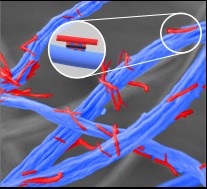News
Functional Mesostructured Electrospun Polymer Nonwovens with Supramolecular Nanofibers
23.03.2022
Andreas Frank, Melina Weber, Christian Hils, Ulrich Mansfeld, Klaus Kreger, Holger Schmalz, Hans-Werner Schmidt
Macromol. Rapid Commun. 2022, https://doi.org/10.1002/marc.202200052

Functional, hierarchically mesostructured nonwovens are of fundamental importance because complex fiber morphologies increase the active surface area and functionality allowing for the effective immobilization of metal nanoparticles. Such complex functional fiber morphologies clearly widen the property profile and enable the preparation of more efficient and selective filter media.
Here, we demonstrate the realization of hierarchically mesostructured nonwovens with barbed wire-like morphology by combining electrospun polystyrene fibers, decorated with patchy worm-like micelles, with solution-processed supramolecular short fibers composed of 1,3,5-benzenetricarboxamides with peripheral N,N-diisopropylaminoethyl substituents. The worm-like micelles with a patchy microphase-separated corona were prepared by crystallization-driven self-assembly of a polyethylene based triblock terpolymer and deposited on top of the polystyrene fibers by coaxial electrospinning. The micelles were designed in a way that their patches promote the directed self-assembly of the 1,3,5-benzenetricarboxamide and the fixation of the supramolecular nanofibers on the supporting polystyrene fibers. Functionality of the mesostructured nonwoven is provided by the peripheral N,N-diisopropylaminoethyl substituents of the 1,3,5-benzenetricarboxamide and proven by the effective immobilization of individual palladium nanoparticles on the supramolecular nanofibers. The preparation of hierarchically mesostructured nonwovens and their shown functionality demonstrate that such systems are attractive candidates to be used for example in filtration, selective separation and heterogenous catalysis.

